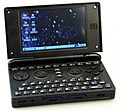Xfce facts for kids

A typical Xfce 4.4 desktop. Various Xfwm effects are visible (drop shadows behind windows, semi-transparent windows and panel).
|
|
| Developer(s) | Multiple developers, enumerated here |
|---|---|
| Stable release |
4.12.0 / April 28, 2015
|
| Operating system | Cross-platform |
| Type | Desktop environment |
| License | GNU General Public License and GNU Lesser General Public License |
Xfce is a special kind of computer program. It is a free software desktop environment. Think of it as the main screen you see and use on your computer. It works on computers that use Unix or similar systems. This includes popular ones like Linux, Solaris, and BSD.
Xfce is designed to be very fast and not use too much of your computer's power. Even though it's lightweight, it still looks good and is simple to use. The current version, 4.12, is built in a smart way. It uses parts that can be easily changed or reused. It is based on something called the GTK+ 2 toolkit. Xfce uses its own special program to manage windows, called Xfwm. You can change all its settings easily with your mouse. The special files that store these settings are hidden away.
The Story of Xfce
The Xfce project started in 1996. A person named Olivier Fourdan began it. The name "Xfce" first stood for "XForms Common Environment." This was because it used a specific set of tools called XForms.
But Xfce has been completely rewritten two times since then. It no longer uses the XForms tools. The name "Xfce" stayed, but it is now written with a small "f" instead of all capital letters.
Xfwm: The Window Manager
Starting with version 4.2, Xfce's window manager got a cool new feature. This program, called Xfwm, now includes its own compositing manager. A compositing manager helps make your desktop look smooth. It allows for cool effects like transparent windows or shadows.
Other compositing managers existed, but they often caused problems. Xfce was one of the first to build its own compositing manager right into the window manager. When it first came out in late 2004, many people said it was the most stable one available. At that time, there was only one other main compositing manager called xcompmgr.
Where Xfce is Used
Xfce is not as common as some other desktop environments like KDE or GNOME. But many Linux distributions still use it. A Linux distribution is like a complete version of the Linux operating system. Some of them even have Xfce as their main desktop. Most others let you choose Xfce if you want it.
Here are some of the Linux distributions that often include Xfce:
- ALTLinux 4.0 Lite (CD)
- Archie
- Debian Xfce CD
- Dreamlinux
- dyne:bolic
- Fedora Xfce Spin
- FreeSBIE (FreeBSD LiveCD)
- Gentoo Linux 2008.0 installation
- KateOS
- Linux Mint Xfce
- Mythbuntu
- Myah OS
- SAM Linux
- Slackware
- SLAX Popcorn Edition
- VectorLinux Standard Edition
- Wolvix
- Xubuntu
- Zenwalk Linux
- Gentoo Linux for the PlayStation 3
Images for kids
See also
 In Spanish: Xfce para niños
In Spanish: Xfce para niños








